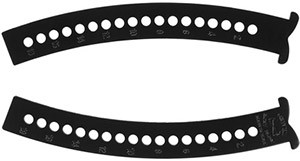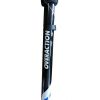Guide for crampons


The first crampons were made of iron or steel and weighed 500-900g. each, surprisingly almost as much as they weigh today. They were tied to the shoe with leather or hemp straps that were passed through special loops.

Experienced climbers of the time advised the climbing public to buy crampons with at least 8 spikes, which is still the case today. But what are they exactly?
What are Crampons?
Crampons are essentially sturdy frames with metal spikes that wrap around the shoes to prevent the possibility of slipping as the spikes are nailed to the ice and the foot is stabilized.

Ice may be encountered at high altitudes year-round, or at lower altitudes during the winter months. However, we may also encounter ice in the city, and it may not be a frequent phenomenon here in Greece in most areas, but in many parts of the world people are forced to move around in snow and ice every day and it is not possible to live every moment with the risk of slipping. So crampons come to the rescue again! No, it's not the chunky climbing crampons with the huge spikes but the so-called microspikes, so let's take a look at each type separately to be prepared for any eventuality!
Crampon Categories
There are 3 categories of mountaineering crampons: C1, C2 και C3.
C1 – Flexible Crampons

Photo: C1flexible crampon
C1s are designed for winter hiking or glacier crossing and are not designed for mountaineering and technical climbing. They usually have 8-10 spikes and some may not have front raised spikes. The front and back of the crampon are joined by a blade which adjusts the length, i.e. the size of the crampon. The lacing is done with straps that go through the toe box, connect to the base of the heel and pull tight to create a secure tie.
Because the binding is with straps it can be worn on any mountaineering boot (B1, B2, B3). However, since the crampon is flexible, the boot may move a little inside even if it is tied firmly, for this reason it is not used for climbing but mainly for walking. It's also good to keep in mind that strapping is definitely more difficult when wearing gloves.
C2 Semi-fast / Hybrid Crampons

Photo: Semi-fast crampon
C2s are also known as hybrids, as they use a strap for the front binding but at the back they clip onto the boot with a special mechanism similar to ski boots. For this reason they only fit semi-rigid B2 and rigid B3 mountaineering boots which have a special notch in the heel to clip onto the crampon. They are semi-rigid and usually have 12 sharp spikes suitable for mountaineering and mixed climbing, but not ideal for technical ice climbing.
C3 Fast Crampons

Photo: Fast crampons
C3s are also known as fast crampons which are completely automated in their tying. They are worn exclusively by technical B3 boots which have special notches in the front and back to automatically clip onto the crampons, just like ski boots. They are completely rigid and completely stable which makes them suitable for big mountains with difficult mixed climbing and mainly for vertical ice climbing, but less convenient for walking. They may have 12 or even 14 spikes which will be very sharp and jagged.
Construction
Their material is usually either steel (plain or stainless steel) or aluminum. Steel is clearly more resistant to hardship while aluminum is lighter. If you are going to use them frequently, stainless steel will definitely last longer.
The basic parts of a crampon are:
1.Binding: Regarding the type of binding we have to choose between crampons with straps, hybrid or automatic.2.The spikes: Crampons can have from 8 to 14 spikes. More technical crampons equals to more and sharper spikes. There are also crampons with a single front spike which allows for greater precision in vertical ice climbing or rock climbing (eg. dry tooling)



Mountain Boot Compatibility

Image Credit: Getty
Mountaineering boots that are compatible with crampons fall into 3 categories:
- B1 Flexible
- B2 Semi-rigid
- B3 Rigid

Source: https://www.advnture.com/feature/types-of-crampon
Microspikes

After examining all the different types of mountaineering crampons, let's have a look at microspikes.
Microspikes are not exactly crampons, but they also consist of spikes which are smaller and hook on snow and ice so that we don't risk slipping in our daily movements. For this reason they are not as big as the climbing ones. In fact, there are some that are very discreet and can be worn with any shoe, city, sports or boots (not recommended for heels, sorry ladies...!) e.g. Petzl Spiky Plus
Sources
https://americanalpineclub.org/news/2017/12/18/the-evolution-of-mountaineering-boots
https://www.advnture.com/feature/types-of-crampon
https://www.rei.com/learn/expert-advice/crampons-snow-ice-climbing.html
https://www.ellis-brigham.com/crampons/crampons-buying-guide
Recent posts
-
24/05/2024Backpack Guide Part Α’ 10 – 30 L
-
20/03/2024Guide for crampons
-
19/02/2024Hangboarding for beginners
-
06/02/2024Rock Climbing in Occupational Therapy
-
23/11/2023Climbing Grades
-
22/11/2023Climbing in psychotherapy
-
16/11/2023What is Bouldering
-
15/11/2023Trad VS Sport Climbing
-
15/11/2023Winter Tents
-
07/11/20233 Season Tents
-
03/11/2023Summer Tents
-
02/11/2023Lifespan Of Your Climbing Gear – Part B Metal Components
-
02/11/2023Lifespan Of Your Climbing Gear – Part A (Harness, Rope, Slings and Webbing)
-
30/10/2023Nail Vernis Aquaglutene - Vade Retro
-
30/10/2023THE LOG BOOK
-
30/10/2023Mountain cookware
-
30/10/2023Our Blog
-
30/10/2023Climbing Shoes - Quick Buying Guide
-
30/10/2023Washing and maintenance of the sleeping bag
-
30/10/2023Superlight Tents
-
30/10/2023ΙNFORMATION FOR CRAMPONS
-
30/10/2023Ice axe
-
30/10/2023INFLATABLE MATTRESS SLEEP
-
30/10/2023Nikwax secrets of waterproofing
-
30/10/2023What Is “Softshell”?
-
30/10/2023Slacklining, ένας εναλλακτικός τρόπος γυμναστικής.
-
30/10/2023Mountaineering - Hiking Boots
-
30/10/2023Waterproof Membranes
-
30/10/2023Sleeping Bags
-
30/10/2023Sleeping Mats
-
30/10/2023Base Layers
-
30/10/2023Climbing Helmets















































































































































































